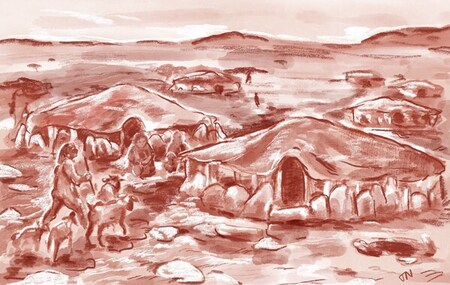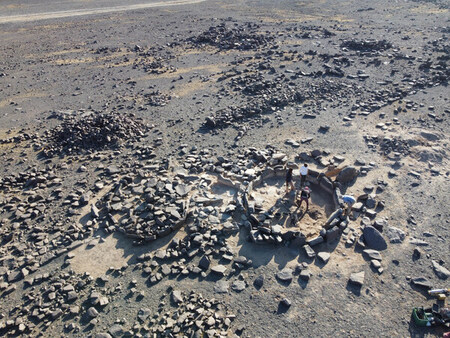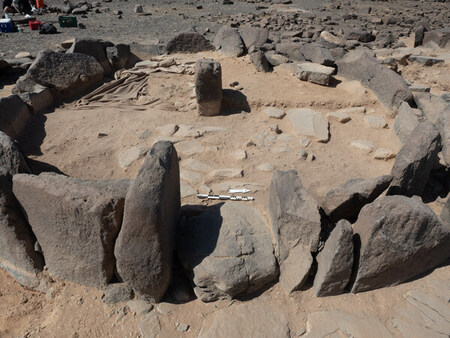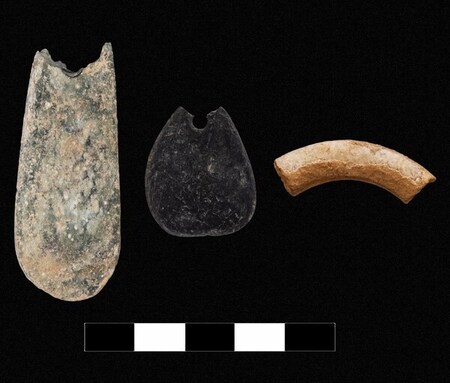ARCHAEOLOGISTS PUBLISH FIRST COMPREHENSIVE DESCRIPTION OF LONG-TERM OCCUPATION SITES IN NORTH-WEST ARABIA DURING NEOLITHIC PERIOD
International team, sponsored by the Royal Commission for AlUla (RCU), analyses unique dwellings described as Standing Stone Circles
Key research into the Neolithic period suggests that region's inhabitants during the 6th and 5th millennia BCE were more settled than previously thought
ALULA, Saudi Arabia, July 10, 2024 /PRNewswire/ -- Ground-breaking archaeological research in AlUla County in north-west Saudi Arabia has published the first comprehensive description and analysis of a long-term dwelling type identified in the region during the Neolithic period.
 Artists’ impression of a small cluster of Standing Stone Circle dwellings during the Neolithic period. A male figure shepherding goats back into the camp, another sits outside, knapping stone tools. The animal skin walls of their dwelling are thrown up while a number of small hearth fires sit cold. (Artist: Thalia Nitz)
Artists’ impression of a small cluster of Standing Stone Circle dwellings during the Neolithic period. A male figure shepherding goats back into the camp, another sits outside, knapping stone tools. The animal skin walls of their dwelling are thrown up while a number of small hearth fires sit cold. (Artist: Thalia Nitz)
This research suggests that the region's inhabitants during the 6th and 5th millennia BCE were more settled than previously thought. They also had a diverse assemblage of cultural material: they herded livestock, made jewellery, and conducted trade along a cultural horizon that extended through the Levant and into eastern Jordan and the Red Sea.
In a report published 2 July, in the peer-reviewed Levant journal, the research led by the University of Sydney archaeologist Jane McMahondescribes latest conclusions and observations of archaeological investigations of structures known as Standing Stone Circles, a unique type of dwelling in which a double row of upright stone slabs was placed in a circle four to eight metres in diameter. The slabs appear to have been used as foundations for timber posts (possibly acacia) wedged between the two rows to support the dwelling's roof, with another slab in the middle also supporting a central timber post lashed to it. While the researchers emphasise that further study is needed, tools and animal remain found at the site suggest that the roofs might have been made of animal skins.
In all, the team studied 431 Standing Stone Circles in the Harrat Uwayrid, a basalt-covered volcanic plateau in AlUla County, with 52 of the structures surveyed and 11 excavated.
Jane McMahon said: "This research is testing assumptions about how the early inhabitants of north-west Arabia lived. They were not just nomadic pastoralists eking out a utilitarian existence. They had distinctive architecture and houses, large quantities of domestic animals, and jewellery and tools with an unexpected and exceptional level of diversity. And based on the number and size of the Standing Stone Circles, they also appear to have been far greater in number than previously thought."
Rebecca Foote, Director of Archaeology and Cultural Heritage Research for RCU, said: "RCU's sponsorship of one of the world's largest archaeological research programmes is deepening our understanding of the region's Neolithic inhabitants. Our earlier studies have shown how they hunted and gathered for ritual, and now we have fresh insight into the fabric of their daily lives. With 12 current surveys, excavations and specialist projects and nine completed, RCU looks forward to learning more about north-west Arabia's rich cultural landscape as we create a global hub of archaeological research and conservation."
The team's analysis of animal remains found at the Standing Stone Circles indicates a mixed subsistence economy, dominated by domestic species, such as goats and sheep, but supplemented by wild species, such as gazelles and birds. The significant reliance on herding would have given inhabitants the flexibility and resilience to respond to environment and resource variability including weather, water and vegetation.
Arrowheads analysed by the team are of type and form analogous with the arrowhead types found in southern and eastern Jordan. Among other evidence, this provides the clearest evidence that the populations of the two areas interacted, though the nature of this interaction is not yet apparent.
Smaller items found at the sites also provide clues to a more interconnected region during this period. For example, the team found gastropod and bivalve shells, which were often pierced with a single hole and possibly used as beads. The genus of the shells matches those in the Red Sea, 120 kilometres to the west, suggesting a connection with the coast during the Neolithic.
Other discoveries include jewellery items such as sandstone and limestone rings or bracelets, as well as pendants. The team also unearthed an ochre-red sandstone crayon, which could have been used for drawing.
"The connected but discrete nature of the Neolithic in AlUla is becoming apparent," the researchers write.
The study's co-authors include Yousef AlBalawi, an AlUla community member who provided ethnographic insights. Students from Saudi universities including King Saud University and the University of Hail also assisted.
The full report can be read at HERE
An image gallery, including an evidence-based sketch of what a Standing Stone Circle might have looked like, can be viewed and downloaded at HERE.
About the Royal Commission for AlUla
The Royal Commission for AlUla (RCU) was established by royal decree in July 2017 to preserve and develop AlUla, a region of outstanding natural and cultural significance in north-west Saudi Arabia. RCU's long-term plan outlines a responsible, sustainable, and sensitive approach to urban and economic development that preserves the area's natural and historic heritage while establishing AlUla as a desirable location to live, work, and visit. This encompasses a broad range of initiatives across archaeology, tourism, culture, education, and the arts, reflecting a commitment to meeting the economic diversification, local community empowerment, and heritage preservation priorities of the Kingdom of Saudi Arabia's Vision 2030 programme.
 The team excavating two spaces within a single Standing Stone Circle. In the background you can see the walls of neighbouring dwellings.
The team excavating two spaces within a single Standing Stone Circle. In the background you can see the walls of neighbouring dwellings.
 An example of a single Standing Stone Circle, a small structure, 4m across with upright stone walls and single standing stone in the centre. A small doorway with threshold stone is located in the centre of the image, inside is a roughly paved surface.
An example of a single Standing Stone Circle, a small structure, 4m across with upright stone walls and single standing stone in the centre. A small doorway with threshold stone is located in the centre of the image, inside is a roughly paved surface.
 Examples of the small jewellery items found in Standing Stone Circles. A. carved stone ring, and carved stone pendants.
Examples of the small jewellery items found in Standing Stone Circles. A. carved stone ring, and carved stone pendants.
PR Newswire Asia Ltd.

PR Newswire
1954年に設立された世界初の米国広報通信社です。配信ネットワークで全世界をカバーしています。Cision Ltd.の子会社として、Cisionクラウドベースコミュニケーション製品、世界最大のマルチチャネル、多文化コンテンツ普及ネットワークと包括的なワークフローツールおよびプラットフォームを組み合わせることで、様々な組織のストーリーを支えています。www.prnasia.com
本プレスリリースは発表元が入力した原稿をそのまま掲載しております。また、プレスリリースへのお問い合わせは発表元に直接お願いいたします。
このプレスリリースには、報道機関向けの情報があります。
プレス会員登録を行うと、広報担当者の連絡先や、イベント・記者会見の情報など、報道機関だけに公開する情報が閲覧できるようになります。















